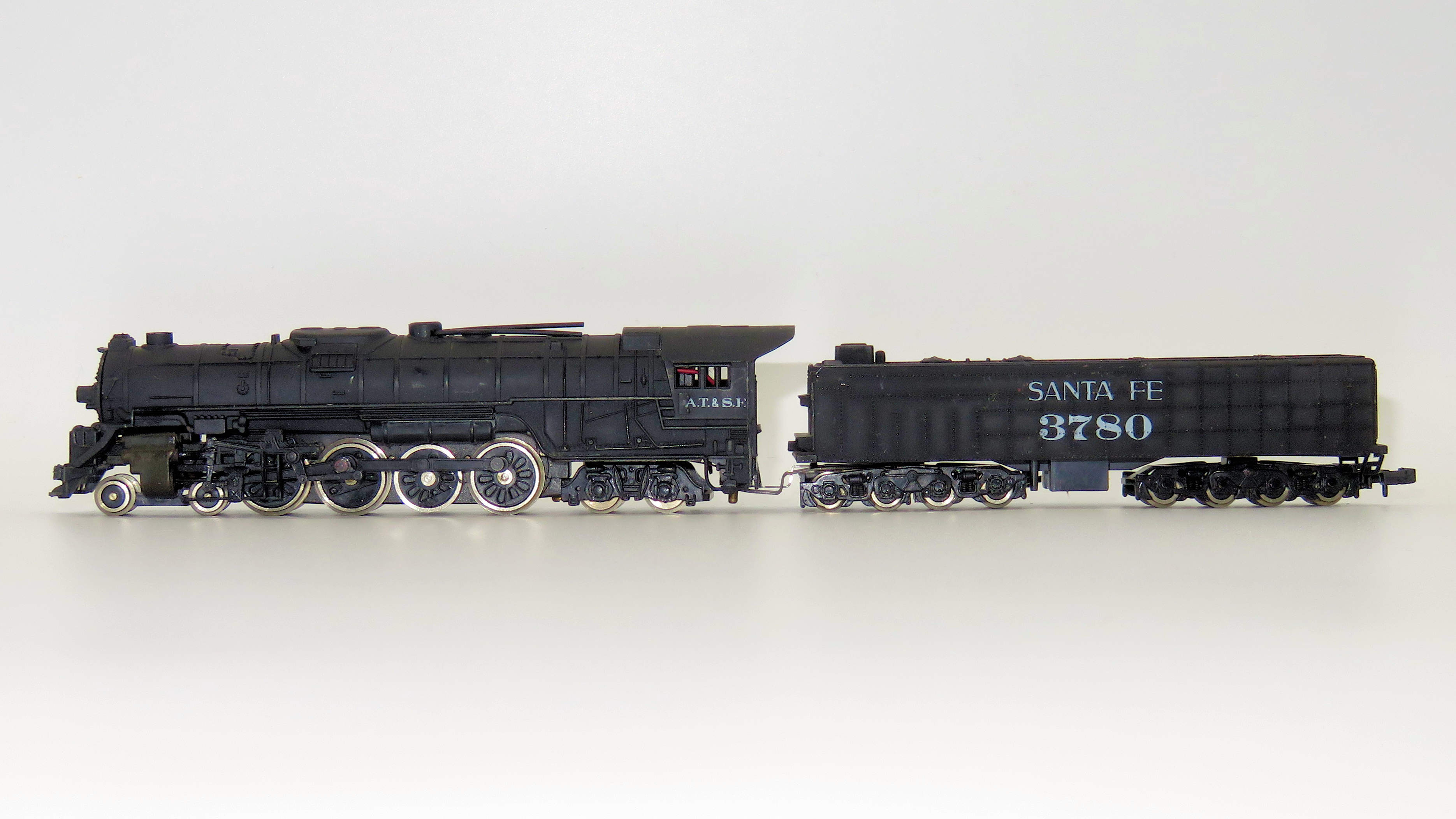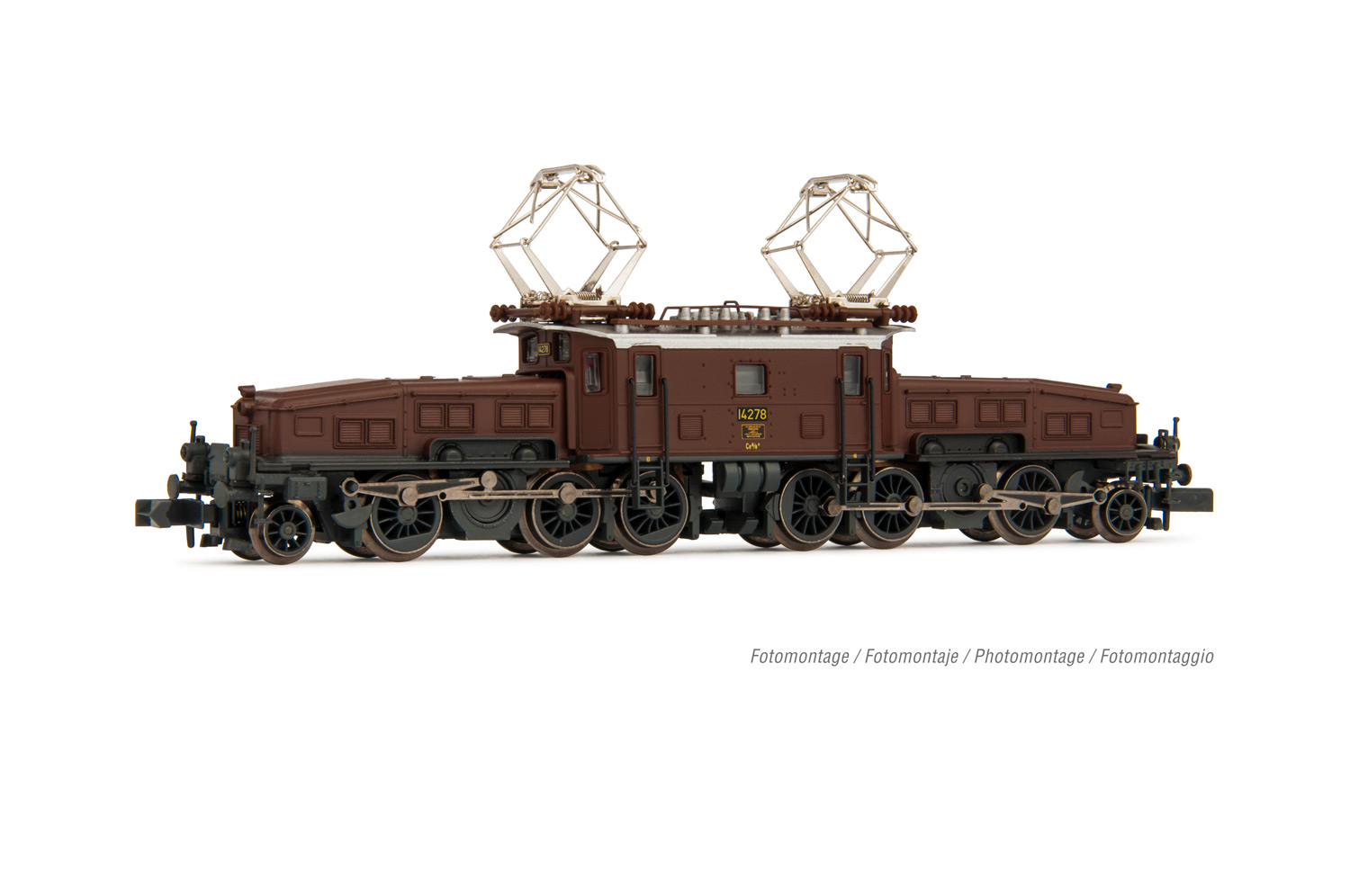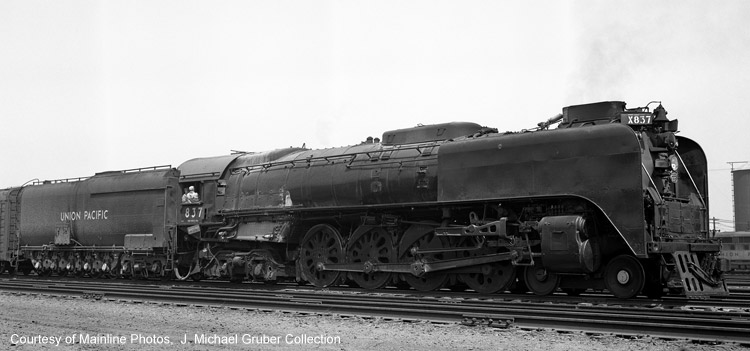Specific Item Information: The Kato FEF-3 844 is appropriate for running in "regular" service (both passenger, helper-passenger and fast freights as well as one excursion trip) from about 1957 t0 1959. Earlier than 1957, it would not have had the Worthington SA feedwater heater modifications to the firebox, under the fireman's side running board, and plumbing as Kato models it.
Model Information: This engine was released in 2014, and Kobo DCC-Installed versions were added in 2015. A 'Freight' version was added in 2016.
This engine has amazing detail and looks fantastic. It was released in conjunction with Kato's Union Pacific Excursion Train Passenger sets. This is a very solid model with a split frame, a coreless motor and dual flywheels. It runs smoothly and quietly and can easily pull a 30 car passenger consist.
The stock model has no front coupler, but a replacement pilot with a dummy coupler is included with the model.
This engine has amazing detail and looks fantastic. It was released in conjunction with Kato's Union Pacific Excursion Train Passenger sets. This is a very solid model with a split frame, a coreless motor and dual flywheels. It runs smoothly and quietly and can easily pull a 30 car passenger consist.
The stock model has no front coupler, but a replacement pilot with a dummy coupler is included with the model.
DCC Information: The DCC upgrade is easy with drop-in decoder design.
The chassis accepts the following plug-in decoders:
- Digitrax DN163K4A: 1.25 Amp N Scale Board Replacement Decoder for Kato N Scale Glacier Express and 4-8-4 FEF Steam Locomotive.
- Digitrax SDXN146K4: Sound decoder for Kato N Scale 4-8-4 FEF and similar Locomotives.
- TCS K6D4: 4 Function Drop-In for Kato FEF.
The chassis accepts the following plug-in decoders:
- Digitrax DN163K4A: 1.25 Amp N Scale Board Replacement Decoder for Kato N Scale Glacier Express and 4-8-4 FEF Steam Locomotive.
- Digitrax SDXN146K4: Sound decoder for Kato N Scale 4-8-4 FEF and similar Locomotives.
- TCS K6D4: 4 Function Drop-In for Kato FEF.
Prototype History: The Union Pacific FEF (Four Eight Four), along with the GS-4 is easily one of the most recognizable US steam prototypes still in operation today. The FEF-3 series of steam locomotives was built by Alco and delivered in 1944 and were the last, and some of the largest, steam locomotives delivered for use by the Union Pacific. Operated solely by the Union Pacific, the FEF's (sometimes referred to as "Northerns", due to the NP's being the first to build steam locomotives with the 4-8-4 wheel arrangement) were intended primarily to be passenger locomotives but the UP's large fleet of available diesels meant that the FEF's were put to work in secondary passenger and fast freight service.
One of the duties of FEF's was to perform helper service with passenger trains that had diesels as their primary motive power. There is photographic documentation of FEF-2 823 on the head end of an AB lash-up of yellow E-7's pulling an extra passenger section. The double-heading was for the steep Wasatch grade. Another photo demonstrates a double-stacked FEF-2 in two tone gray as the only power on an extra section of The Gold Coast. Both photos were taken in 1952. Another photo exists of an FEF shoving on the back of a freight, pulling a yellow CA-4 caboose in freight helper service too.
Today, FEF-3 #844 (at some times during history also known as #8444 to avoid numbering conflicts with a diesel loco) survives to pull excursion trains as a publicity locomotive for the Union Pacific, and is one the UP's oldest operating locomotives.
Accompanying the "living legend" FEF-3 is always at least one of a pair of Union Pacific Water Tenders, carrying spare water for the steam engine (Water filling stations being a rarity in the diesel era). These unique re-built cars have seen service as both Steam and Gas Turbine Electric fuel tenders before finally settling into their current forms as part of UP's steam heritage fleet where they operate as separate (but always-present) cars.
One of the duties of FEF's was to perform helper service with passenger trains that had diesels as their primary motive power. There is photographic documentation of FEF-2 823 on the head end of an AB lash-up of yellow E-7's pulling an extra passenger section. The double-heading was for the steep Wasatch grade. Another photo demonstrates a double-stacked FEF-2 in two tone gray as the only power on an extra section of The Gold Coast. Both photos were taken in 1952. Another photo exists of an FEF shoving on the back of a freight, pulling a yellow CA-4 caboose in freight helper service too.
Today, FEF-3 #844 (at some times during history also known as #8444 to avoid numbering conflicts with a diesel loco) survives to pull excursion trains as a publicity locomotive for the Union Pacific, and is one the UP's oldest operating locomotives.
Accompanying the "living legend" FEF-3 is always at least one of a pair of Union Pacific Water Tenders, carrying spare water for the steam engine (Water filling stations being a rarity in the diesel era). These unique re-built cars have seen service as both Steam and Gas Turbine Electric fuel tenders before finally settling into their current forms as part of UP's steam heritage fleet where they operate as separate (but always-present) cars.
Road Name History: The Union Pacific Railroad (reporting mark UP) is a freight hauling railroad that operates 8,500 locomotives over 32,100 route-miles in 23 states west of Chicago, Illinois and New Orleans, Louisiana. The Union Pacific Railroad network is the largest in the United States and employs 42,600 people. It is also one of the world's largest transportation companies.
Union Pacific Railroad is the principal operating company of Union Pacific Corporation (NYSE: UNP); both are headquartered in Omaha, Nebraska. Over the years Union Pacific Corporation has grown by acquiring other railroads, notably the Missouri Pacific, Chicago & North Western, Western Pacific, Missouri-Kansas-Texas, and the Southern Pacific (including the Denver & Rio Grande Western).
Union Pacific Corporation's main competitor is the BNSF Railway, the nation's second largest freight railroad, which also primarily services the Continental U.S. west of the Mississippi River. Together, the two railroads have a duopoly on all transcontinental freight rail lines in the U.S.
Read more on Wikipedia and on Union Pacific official website.
Union Pacific Railroad is the principal operating company of Union Pacific Corporation (NYSE: UNP); both are headquartered in Omaha, Nebraska. Over the years Union Pacific Corporation has grown by acquiring other railroads, notably the Missouri Pacific, Chicago & North Western, Western Pacific, Missouri-Kansas-Texas, and the Southern Pacific (including the Denver & Rio Grande Western).
Union Pacific Corporation's main competitor is the BNSF Railway, the nation's second largest freight railroad, which also primarily services the Continental U.S. west of the Mississippi River. Together, the two railroads have a duopoly on all transcontinental freight rail lines in the U.S.
Read more on Wikipedia and on Union Pacific official website.
Brand/Importer Information: KATO U.S.A. was established in 1986, with the first U.S. locomotive model (the GP38-2, in N-Scale) released in 1987. Since that time, KATO has come to be known as one of the leading manufacturers of precision railroad products for the modeling community. KATO's parent company, Sekisui Kinzoku Co., Ltd., is headquartered in Tokyo, Japan.
In addition to producing ready-to-run HO and N scale models that are universally hailed for their high level of detail, craftsmanship and operation, KATO also manufactures UNITRACK. UNITRACK is the finest rail & roadbed modular track system available to modelers today. With the track and roadbed integrated into a single piece, UNITRACK features a nickel-silver rail and a realistic-looking roadbed. Patented UNIJOINERS allow sections to be snapped together quickly and securely, time after time if necessary.
The Kato U.S.A. office and warehouse facility is located in Schaumburg, Illinois, approximately 30 miles northwest of Chicago. All research & development of new North American products is performed here, in addition to the sales and distribution of merchandise to a vast network of wholesale representatives and retail dealers. Models requiring service sent in by hobbyists are usually attended to at this location as well. The manufacturing of all KATO products is performed in Japan.
Supporters of KATO should note that there is currently no showroom or operating exhibit of models at the Schaumburg facility. Furthermore, model parts are the only merchandise sold directly to consumers. (Please view the Parts Catalog of this website for more specific information.)
In addition to producing ready-to-run HO and N scale models that are universally hailed for their high level of detail, craftsmanship and operation, KATO also manufactures UNITRACK. UNITRACK is the finest rail & roadbed modular track system available to modelers today. With the track and roadbed integrated into a single piece, UNITRACK features a nickel-silver rail and a realistic-looking roadbed. Patented UNIJOINERS allow sections to be snapped together quickly and securely, time after time if necessary.
The Kato U.S.A. office and warehouse facility is located in Schaumburg, Illinois, approximately 30 miles northwest of Chicago. All research & development of new North American products is performed here, in addition to the sales and distribution of merchandise to a vast network of wholesale representatives and retail dealers. Models requiring service sent in by hobbyists are usually attended to at this location as well. The manufacturing of all KATO products is performed in Japan.
Supporters of KATO should note that there is currently no showroom or operating exhibit of models at the Schaumburg facility. Furthermore, model parts are the only merchandise sold directly to consumers. (Please view the Parts Catalog of this website for more specific information.)
Item created by: Powderman on 2023-03-19 12:20:20. Last edited by CNW400 on 2024-04-03 14:51:51
If you see errors or missing data in this entry, please feel free to log in and edit it. Anyone with a Gmail account can log in instantly.
If you see errors or missing data in this entry, please feel free to log in and edit it. Anyone with a Gmail account can log in instantly.











